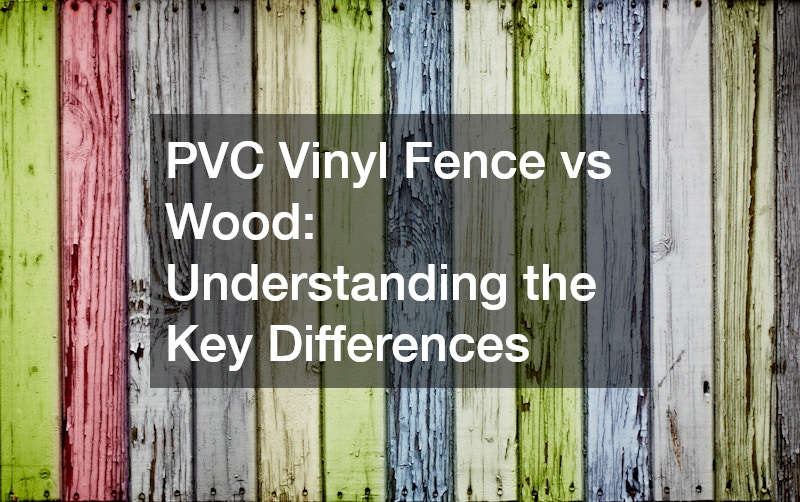When it comes to choosing the right fence for a property, homeowners often find themselves comparing PVC vinyl fences to traditional wood fences. Both materials have been popular choices for years, each offering its own set of advantages and considerations. Understanding the differences between the two can help property owners make an informed decision that aligns with their goals for appearance, durability, and maintenance.
Appearance and Aesthetic Options
Wood fencing has long been valued for its timeless and natural look. Its grain, color, and texture bring a warm and classic appeal that complements many landscapes and architectural styles.
Because wood can be stained or painted in virtually any shade, it offers a high degree of customization. This flexibility makes wood attractive for homeowners who enjoy personalizing their outdoor spaces.
PVC vinyl fencing, on the other hand, provides a clean and modern appearance. Designed to mimic the look of painted wood, vinyl fences often come in a range of colors and styles, including picket, privacy, and decorative designs. While the natural variations of real wood cannot be fully replicated, vinyl delivers a uniform, polished look that remains consistent over time. For those who prefer a sleek aesthetic with less upkeep, vinyl is a strong contender.
Durability and Longevity
One of the major differences between PVC vinyl and wood fencing lies in durability. Wood is a natural material that, while strong, is susceptible to environmental stressors such as moisture, insects, and rot. Over time, wooden fences may warp, crack, or require replacement of boards and posts. Regular care is necessary to preserve the fence and keep it in good condition.
PVC vinyl fencing stands out for its resilience. Built from engineered materials, vinyl resists moisture, insect damage, and decay. It does not splinter or warp, and it holds up well against changing weather conditions. A properly installed vinyl fence can maintain its structural integrity and appearance for many years with minimal attention, making it an appealing choice for long-term durability.
Maintenance Requirements
Maintenance is another area where wood and PVC vinyl differ significantly. Wood fences require routine upkeep to extend their lifespan. This often includes staining, sealing, or painting to protect the material from the elements. Neglecting these steps can lead to faster deterioration and the need for frequent repairs.
PVC vinyl fences, by contrast, are known for their low maintenance. They do not need to be painted or sealed, and they resist fading and discoloration. Typically, all that is required to keep a vinyl fence looking its best is an occasional rinse with a garden hose or a light scrub with soap and water. This ease of care makes vinyl a convenient option for property owners with busy schedules or those who prefer not to commit to frequent maintenance tasks.
Environmental Considerations
Wood is a renewable resource, and many people value its natural origin. However, the treatment processes used to protect wood against pests and moisture often involve chemicals. Additionally, harvesting wood for fencing does have an environmental impact, though sustainable forestry practices can help reduce this concern.
PVC vinyl fencing is manufactured from synthetic materials, which means it is not a natural product. However, many vinyl fences are recyclable, and manufacturers are increasingly working to improve sustainability in production. For homeowners considering environmental factors, it’s worth weighing the renewable aspect of wood against the long-lasting, recyclable qualities of vinyl.
Installation and Stability
Both wood and PVC vinyl fences can be installed in similar ways, using posts, rails, and panels. Wood may require more careful adjustments during installation due to natural variations in size and shape. Over time, wooden posts may shift or lean if not properly treated against moisture in the ground.
PVC vinyl fences are manufactured with consistent sizing, making installation straightforward and uniform. They often feature interlocking panels or rails designed for quick assembly. Once in place, vinyl tends to remain stable and requires fewer adjustments over time, which adds to its appeal for property owners seeking a long-lasting structure.
Choosing the Right Option for Your Property
Ultimately, the decision between a wood fence and a PVC vinyl fence comes down to priorities. Homeowners who value a traditional, natural look and don’t mind routine maintenance may gravitate toward wood. Its classic charm and customizable finish continue to make it a popular choice.
For those who prefer a low-maintenance, long-lasting solution with a consistent modern appearance, PVC vinyl fencing is often the better option. It resists common issues such as rot and insect damage while maintaining its polished look with minimal effort.
When making a decision, it can be helpful to consult with a professional installer. A reputable PVC fence company can provide guidance on styles, installation methods, and the benefits of vinyl fencing compared to wood. Likewise, fencing specialists who work with wood can explain the best care practices and options for maximizing longevity.
Both wood and PVC vinyl fences bring value and appeal, but they serve different needs. Wood offers warmth, tradition, and customizability, while vinyl provides durability, low maintenance, and a modern finish. By understanding these differences, property owners can choose the fence material that aligns with their vision and lifestyle. Whether enhancing privacy, adding curb appeal, or defining property boundaries, the right fence makes a lasting impact on any home.





